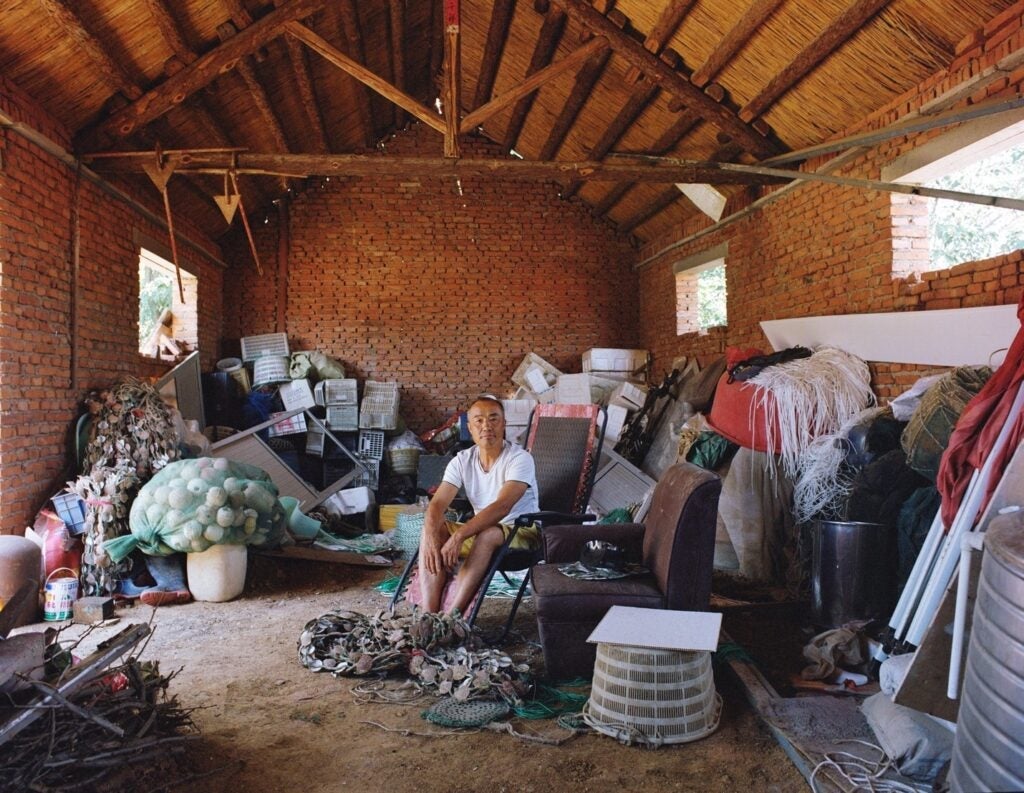Aquaculture and Community Vulnerability: How Positionality Shapes Public Health Perspectives

A worker cleaning the macroalgal bloom in Qingdao. The bloom is destructive for certain types of offshore aquaculture, and some believe it results from overcrowded seaweed aquaculture.
By Zhengyuan Wang
Rose Service Learning Fellow
SM Candidate, Environmental Health
“Eat more fish to become smarter.” “Eating fish will improve your vision.” These were sayings I often heard from my parents while growing up in Qingdao, China, a bustling city of over 10 million residents with a rich seafood culture.
While seafood provides essential micronutrients and plays a key role in our food systems and subsistence, aquaculture sectors, particularly small-scale, family-based, and traditional operations in developing countries like China- face critical challenges yet are often overlooked due to their distance from urban centers. These sectors must demonstrate resilience to environmental and social transformations while simultaneously evolving toward more sustainable production methods, ensuring the continued provision of valuable and safe nutritional resources. Engaging directly with the community is essential to deepen our understanding of policy-driven public health initiatives and their potential for local adaptation.
This summer, under the mentorship of Dr. Christopher Golden and in collaboration with the Yellow Sea Fisheries Research Institute (YSFRI), Chinese Academy of Fishery Sciences (CAFS), I engaged with a broad spectrum of stakeholders—aquaculture farmers, contractors, wholesalers, workers, seafood export companies, and aquaculture experts—through follow-up interviews, field assessments, random conversations, and questionnaires. I sought to understand their perspectives on seafood consumption as a source of nutrition, as well as their views on food safety, sustainability, and subsistence within the aquaculture sector, from both cultural and socio-economic standpoints. How can this sector become more resilient to environmental and economic stressors while continuing to provide essential health benefits to communities?
Returning to my hometown was both nostalgic and eye opening. Growing up here, I thought I knew the community well—its cultural nuances, the not very commonly spoken dialect, and the local seafood cuisines served on the table. However, as I explored public health issues through a community engagement lens, I realized the dynamics were far more complex than I had anticipated. Recognizing my own positionality—as a local who spent my childhood here and is now pursuing a career in public health—was a unique identity that was challenging for me. However, it also allowed me to reflect on the perspectives, approaches, and biases I brought into my interactions with the community.
As my connection with various community members deepened, my understanding also solidified. I learned about the perceived health benefits of consuming seafood and the palpable concerns they had regarding food safety. They shared memories of arduous labor in the past, discussed why younger generations have moved to urban areas in pursuit of better opportunities, and lamented the decline of fisheries and the impact of the four-month fishing ban. Aquaculture farmers expressed their frustrations with bureaucratic failures and the decreasing availability of farming space, while committed nonprofit workers shared their aspirations to revive seagrass beds.
Moral dilemmas became a deeply personal takeaway for me—the more I explored the balance between environmental stewardship and family subsistence, the more helpless I felt in the face of a power system that made me feel insignificant. It seemed there was never a singular solution, let alone one that could accommodate everyone’s needs. Yet, the vivid tones and emotions of these conversations brought me back to the heart of the issue—the people.
Moving from one fishing village to another, I began to understand that each community is just one among thousands, with each having its own unique context. Building proximity, trust, and long-term commitment are vital elements of this journey. Only when I witness something firsthand can I truly grasp the depth of its reality, and being on the ground brings everything to life—not as abstract text or jargon, but as a living, breathing reality.

Lao Wang, a local oyster farmer in Qigou village, has been growing oysters for decades using traditional methods. He drills holes in scallop shells, threads them, and deploys them into offshore waters, where wild spat naturally attach. In our conversation, he shared his concerns within the aquaculture sector and his personal journey as an immigrant building relationships within the community. He discussed the gap between practical experience and research, particularly in the absence of current solutions to address the massive mortality of oysters in recent years, as well as the protective measures needed to manage the growing public fear regarding seafood safety and recession in aquaculture businesses due to the Fukushima Nuclear Plant radioactive wastewater discharge. Lao Wang also told me their perspective of the need to live in harmony with the environment to ensure a sustainable future for all- especially when livelihoods like his are entirely at the mercy of the weather.

Learning from community members like Lao Wang offers a valuable lesson in balancing sense and sensibility, reminding me of my goal to become a public health practitioner and researcher: engaging with the community to empower stakeholders and advocate for their needs. For Lao Wang, integrating policy considerations that provide technical and financial support for individual farmers, incorporating community input into environmental legislation, and emphasizing the public health benefits of supporting these businesses could significantly improve outcomes for him and others like him, instead of unintentionally troubling these businesses or putting the industry in a less resilient position for the future.
After many conversations with Lao Wang, he agreed to let me capture his story through photography, a piece of which I later featured in a short article. “I never thought about appearing internationally. It would be a great mission for you to share our stories with the world,” Lao Wang said.


